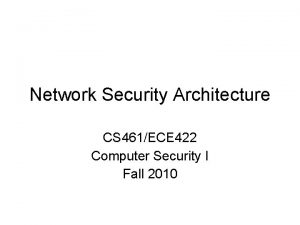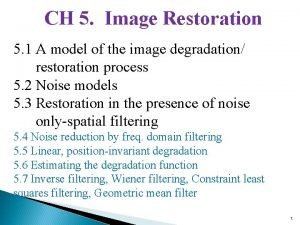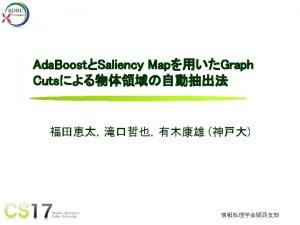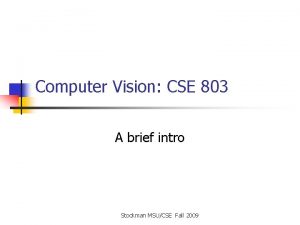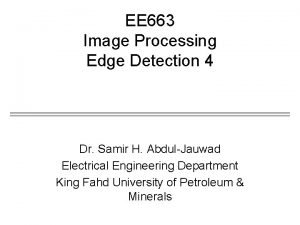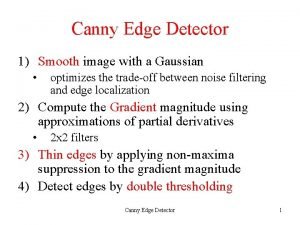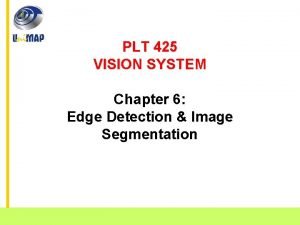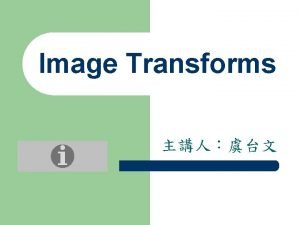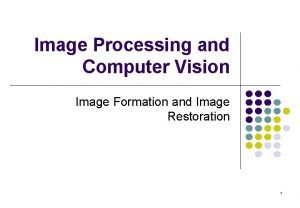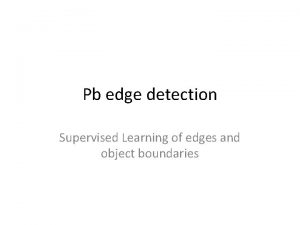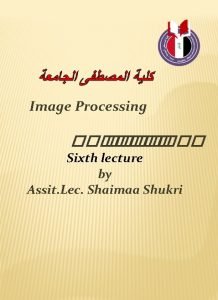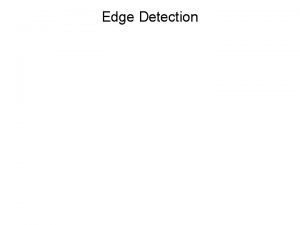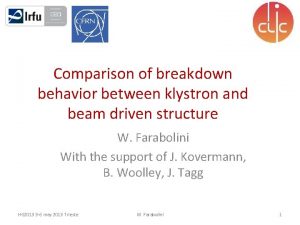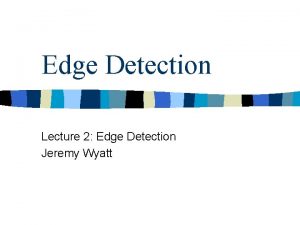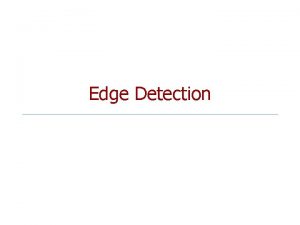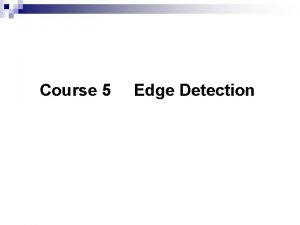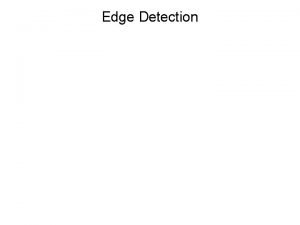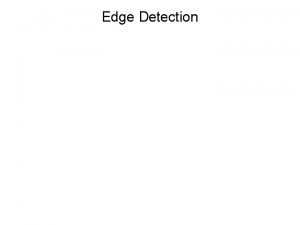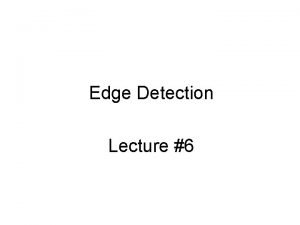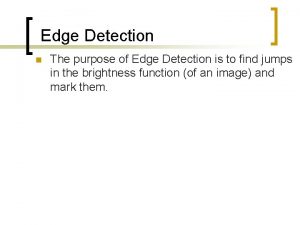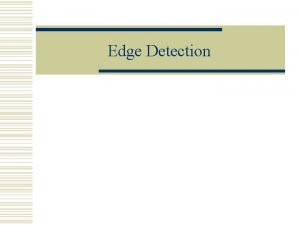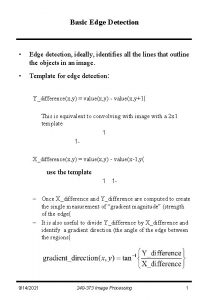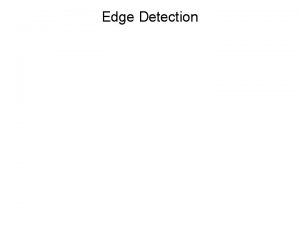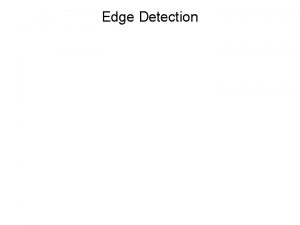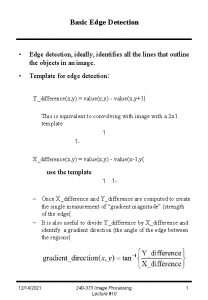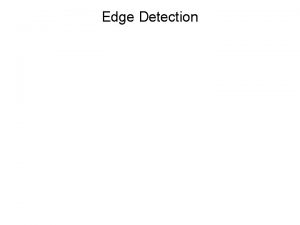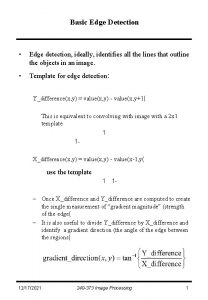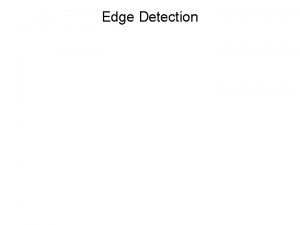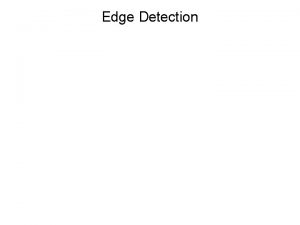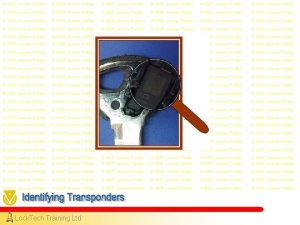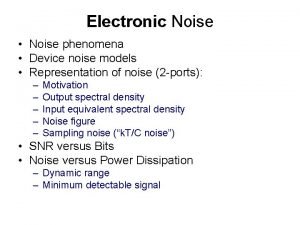Noise Filtering Edge Detection Jeremy Wyatt Filtering n



























- Slides: 27

Noise Filtering & Edge Detection Jeremy Wyatt

Filtering n Last time we saw that we could detect edges by calculating the intensity change (gradient) across the image n We saw that we could implement this using the idea of filtering -1 0 1 1 3 4 5 -2 0 0 2 3 3 4 -1 0 0 4 6 3 5 0 0 0 4 4 3 0 0 0 3 5 2 0 0 5 5 0 0 4 3

Linear filtering: the algorithm for i=2: image_height-1 for j=2: image_width-1 end y+2 j+x x+2 -1 0 1 1 3 4 5 -2 0 0 2 3 3 4 -1 0 0 4 6 3 5 0 0 0 4 4 3 0 0 0 3 5 2 0 0 5 5 0 0 4 3 i+y NB We count from the upper left, and in MATLAB we start at 1 j i

Linear Filtering: the algorithm for i=2: image_height-1 for j=2: image_width-1 end y+2 j+x x+2 j=2 -1 0 1 1 3 4 5 -2 0 0 2 3 3 4 -1 0 0 4 6 3 5 0 0 0 4 4 3 0 0 0 3 5 2 0 0 5 5 0 0 4 3 i+y i=2 0

Linear Filtering: the algorithm for i=2: image_height-1 for j=2: image_width-1 end y+2 j+x x+2 j=2 -1 0 1 1 3 4 5 -2 0 0 2 3 3 4 -1 0 0 4 6 3 5 0 0 0 4 4 3 0 0 0 3 5 2 0 0 5 5 0 0 4 3 i+y i=2 0

Linear Filtering: the algorithm for i=2: image_height-1 for j=2: image_width-1 end y+2 j+x x+2 j=2 -1 0 1 1 3 4 5 -2 0 0 2 3 3 4 -1 0 0 4 6 3 5 0 0 0 4 4 3 0 0 0 3 5 2 0 0 5 5 0 0 4 3 i+y i=2 1

Linear Filtering: the algorithm for i=2: image_height-1 for j=2: image_width-1 end y+2 j+x x+2 j=2 -1 0 1 1 3 4 5 -2 0 0 2 3 3 4 -1 0 0 4 6 3 5 0 0 0 4 4 3 0 0 0 3 5 2 0 0 5 5 0 0 4 3 i+y i=2 1

Linear Filtering: the algorithm for i=2: image_height-1 for j=2: image_width-1 end y+2 j+x x+2 j=2 -1 0 1 1 3 4 5 -2 0 0 2 3 3 4 -1 0 0 4 6 3 5 0 0 0 4 4 3 0 0 0 3 5 2 0 0 5 5 0 0 4 3 i+y i=2 1

Linear Filtering: the algorithm for i=2: image_height-1 for j=2: image_width-1 end y+2 j+x x+2 j=2 -1 0 1 1 3 4 5 -2 0 0 2 3 3 4 -1 0 0 4 6 3 5 0 0 0 4 4 3 0 0 0 3 5 2 0 0 5 5 0 0 4 3 i+y i=2 5

Linear Filtering: the algorithm for i=2: image_height-1 for j=2: image_width-1 end y+2 j+x x+2 j=2 -1 0 1 1 3 4 5 -2 0 0 2 3 3 4 -1 0 0 4 6 3 5 0 0 0 4 4 3 0 0 0 3 5 2 0 0 5 5 0 0 4 3 i+y i=2 5

Linear Filtering: the algorithm for i=2: image_height-1 for j=2: image_width-1 end y+2 j+x x+2 j=2 -1 0 1 1 3 4 5 -2 0 0 2 3 3 4 -1 0 0 4 6 3 5 0 0 0 4 4 3 0 0 0 3 5 2 0 0 5 5 0 0 4 3 i+y i=2 5

Linear Filtering: the algorithm for i=2: image_height-1 for j=2: image_width-1 end y+2 j+x x+2 j=2 -1 0 1 1 3 4 5 -2 0 0 2 3 3 4 -1 0 0 4 6 3 5 0 0 0 4 4 3 0 0 0 3 5 2 0 0 5 5 0 0 4 3 i+y i=2 9

Linear Filtering: the algorithm for i=2: image_height-1 for j=2: image_width-1 end y+2 j+x x+2 j=3 -1 0 1 1 3 4 5 -2 0 0 2 3 3 4 -1 0 0 4 6 3 5 0 0 0 4 4 3 0 0 0 3 5 2 0 0 5 5 0 0 4 3 i+y i=2 9 14

Linear Filtering: the algorithm for i=2: image_height-1 for j=2: image_width-1 end y+2 j+x x+2 j=4 -1 0 1 1 3 4 5 -2 0 0 2 3 3 4 -1 0 0 4 6 3 5 0 0 0 4 4 3 0 0 0 3 5 2 0 0 5 5 0 0 4 3 i+y i=2 9 14 4

Linear Filtering: the algorithm for i=2: image_height-1 for j=2: image_width-1 end y+2 j+x x+2 j=5 -1 0 1 1 3 4 5 -2 0 0 2 3 3 4 -1 0 0 4 6 3 5 0 0 0 4 4 3 0 0 0 3 5 2 0 0 5 5 0 0 4 3 i+y i=2 9 14 4 3

Linear Filtering: the algorithm for i=2: image_height-1 for j=2: image_width-1 end y+2 j+x x+2 j=2 -1 0 1 1 3 4 5 -2 0 0 2 3 3 4 -1 0 0 4 6 3 5 0 0 0 4 4 3 0 0 0 3 5 2 0 0 5 5 0 0 4 3 i+y 9 i=3 10 14 4 3

Linear Filtering: the algorithm for i=2: image_height-1 for j=2: image_width-1 end y+2 j+x x+2 j=3 -1 0 1 1 3 4 5 -2 0 0 2 3 3 4 -1 0 0 4 6 3 5 0 0 0 4 4 3 0 0 0 3 5 2 0 0 5 5 0 0 4 3 i+y i=3 9 14 10 16 4 3

Linear Filtering: the algorithm for i=2: image_height-1 for j=2: image_width-1 end y+2 j+x x+2 j=4 -1 0 1 1 3 4 5 -2 0 0 2 3 3 4 -1 0 0 4 6 3 5 0 0 0 4 4 3 0 0 0 3 5 2 0 0 5 5 0 0 4 3 i+y i=3 9 14 4 10 16 3 3

Linear Filtering: the algorithm for i=2: image_height-1 for j=2: image_width-1 end y+2 j+x x+2 j=5 -1 0 1 1 3 4 5 -2 0 0 2 3 3 4 -1 0 0 4 6 3 5 0 0 0 4 4 3 0 0 0 3 5 2 0 0 5 5 0 0 4 3 i+y i=3 9 14 4 3 10 16 4 -2

Noise filtering n We can use convolution to remove noise as we mentioned, e. g. mean filter This is a linear filter n The most widely used is Gaussian filtering n 0 . 01 . 02 . 01 0 . 01 . 06 . 11 . 06 . 01 . 02 . 11 . 16 . 11 . 02 . 01 . 06 . 11 . 06 . 01 0 . 01 . 02 . 01 0

Effect of mean filtering Original 3 x 3 filter 5 x 5 filter

Horizontal Sobel operator Abs(Gx) Threshold=30 5 x 5 Mean Filter Horizontal Sobel operator Abs(Gx) Threshold=30

Effect of Gaussian filtering Original 5 x 5 filter Horizontal Sobel Operator Abs(Gx) Threshold = 30

Sequenced filters We can replace a 2 d Gaussian filter with 2, 1 d Gaussian filters in sequence 0. 003 . 0133 . 0219 . 0133 0. 003 . 0133 . 0596 . 0983 . 0596 . 0133 . 0219 . 0983 . 1621 . 0983 . 0219 . 0545 . 2442 . 4026 . 0545. 0133 . 0596 . 0983 . 0596 . 0133. 2442 0. 003 . 0133 . 0219 . 0133 0. 003. 4026 . 2442 . 0545

Gaussian edge detection n We can take the first derivative of the masks and then convolve with those. 1897 . 1741 0 . 1741 . 1897 n Then we can combine the resulting images using the formula for magnitude n However when thresholded we can see that this loses edge information n How can we keep this?

Second order operators n Thresholding the first derivative of the smoothed signal thickens the edges and also we lose some useful edges n One solution is therefore to take the second derivative instead n A basic second order mask is the Laplacian 0 1 -4 1 0

Reading n RC Jain, Chapter 4
 Jeremy c wyatt
Jeremy c wyatt En la basura
En la basura Ingress filtering vs egress filtering
Ingress filtering vs egress filtering Restoration in the presence of noise only-spatial filtering
Restoration in the presence of noise only-spatial filtering Quantization noise in pcm
Quantization noise in pcm Leading edge detection
Leading edge detection Convolution edge detection
Convolution edge detection Edge detection
Edge detection Normalized cut segmentation
Normalized cut segmentation Edge detection
Edge detection Edge detection
Edge detection Edge detection
Edge detection What is canny edge detection in image processing
What is canny edge detection in image processing Texas instruments matlab
Texas instruments matlab Edge detection
Edge detection Edge detection
Edge detection Computer graphic
Computer graphic Edge detection
Edge detection Edge detection sobel
Edge detection sobel Canny mask
Canny mask Rising edge and falling edge
Rising edge and falling edge Wyatt
Wyatt Ron wyatt md
Ron wyatt md Sonnets of wyatt and surrey
Sonnets of wyatt and surrey Cruzando el mar rojo
Cruzando el mar rojo Ron wyatt faux
Ron wyatt faux Whoso list to hunt context
Whoso list to hunt context My galley poem
My galley poem


